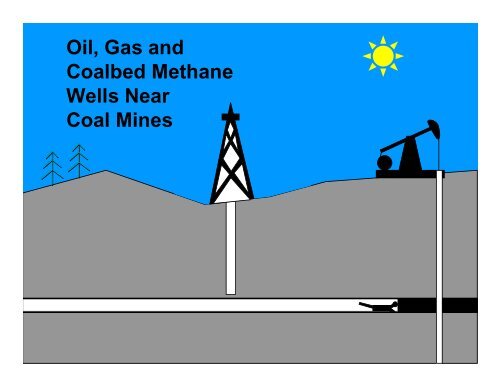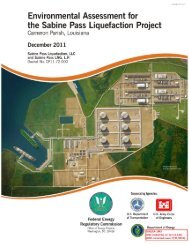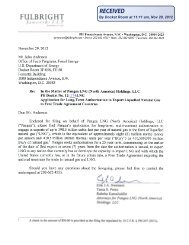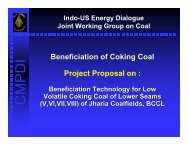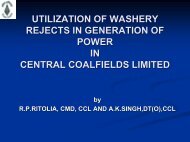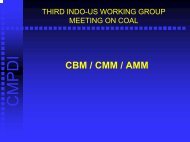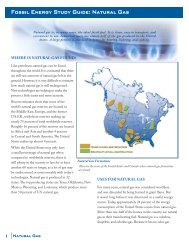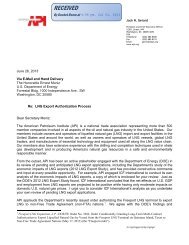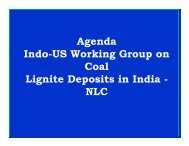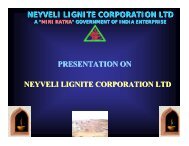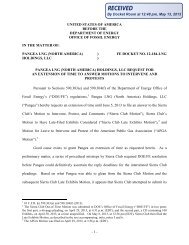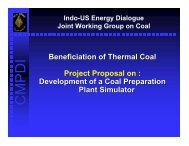Oil, Gas and CBM Wells Near Coal Mines - Office of Fossil Energy
Oil, Gas and CBM Wells Near Coal Mines - Office of Fossil Energy
Oil, Gas and CBM Wells Near Coal Mines - Office of Fossil Energy
Create successful ePaper yourself
Turn your PDF publications into a flip-book with our unique Google optimized e-Paper software.
<strong>Oil</strong>, <strong>Gas</strong> <strong>and</strong><br />
<strong>Coal</strong>bed Methane<br />
<strong>Wells</strong> <strong>Near</strong><br />
<strong>Coal</strong> <strong>Mines</strong>
<strong>Oil</strong> <strong>and</strong> <strong>Gas</strong> Well Hazards<br />
• Inundation<br />
– <strong>Gas</strong><br />
– <strong>Oil</strong><br />
– Water<br />
• Ignition source<br />
– Mine into casing<br />
– Drill into active mine<br />
• Underground piping<br />
– Leaks
Inches From Disaster<br />
850 psi<br />
Natural <strong>Gas</strong>
Jurisdictional Problem<br />
• <strong>Oil</strong> <strong>and</strong> gas wells are regulated by<br />
states<br />
• MSHA only has jurisdiction over mines<br />
– Only when a coal mine is near an oil or gas<br />
well is MSHA able to take enforcement<br />
actions<br />
– Most oil <strong>and</strong> gas drillers <strong>and</strong> coal mines<br />
have been cooperative in dealing with this<br />
potential issue
<strong>Oil</strong> <strong>and</strong> <strong>Gas</strong> <strong>Wells</strong><br />
• 300 ft. diameter barrier<br />
• Petition for modification<br />
– Bu<strong>Mines</strong> research 1970’s<br />
– Redrill, replug, prior to mining intersection<br />
• Similar to many state regulations
<strong>Coal</strong>bed Methane (<strong>CBM</strong>)<br />
• Methane produced from coal<br />
seams <strong>and</strong> surrounding strata<br />
• <strong>CBM</strong> production reduces methane<br />
emissions during mining<br />
• Several types <strong>of</strong> <strong>CBM</strong> wells<br />
• Ab<strong>and</strong>onment issues<br />
– Plugging<br />
– Location
GOB<br />
GOB<br />
30 – 50 ft.<br />
Degas<br />
Long<br />
Holes<br />
Water Infusion<br />
Gateroad<br />
100 – 300 ft.<br />
Spacing<br />
Flex<br />
Pipe<br />
Collection<br />
Pipe<br />
Pneumatic<br />
Valve (NC)<br />
Detection<br />
Pipe<br />
GOB<br />
GOB<br />
Grouted +8,000 ft.<br />
St<strong>and</strong>pipe<br />
15 – 20 ft.<br />
Longwall Panel<br />
Future<br />
Sub-mains<br />
Mains<br />
Open<br />
Hole<br />
From MSHA IR-1094<br />
“Piping Methane<br />
In Underground <strong>Coal</strong> <strong>Mines</strong>”<br />
Longwall<br />
GOB GOB GOB<br />
Horizontal Cross-panel Holes<br />
Plan View<br />
Plan View<br />
Cross-section View<br />
GOB<br />
Horizontal Directional Holes<br />
Underground Methane Piping<br />
Long Horizontal Holes<br />
Sub-mains<br />
Plan View
Dewatering<br />
Pump<br />
To<br />
Pipeline<br />
Non-producing<br />
Gob Well<br />
4 – 10<br />
Dewatering<br />
in.<br />
Pump<br />
Cased Hole<br />
7 to 12 inch<br />
Cased or<br />
Uncased<br />
Hole<br />
Up to 2 miles<br />
To<br />
Pipeline<br />
800 to 2,500 ft.<br />
IC Engine<br />
Producing<br />
Gob Well<br />
Blower<br />
To<br />
Pipeline<br />
CH 4 Vent<br />
Or To<br />
Compressor<br />
Equivalent<br />
Vertical Holes<br />
Production Well<br />
12 - 18 in.<br />
Cased Hole<br />
Directional<br />
Hole System<br />
Perforations<br />
<strong>Coal</strong> Seam<br />
Caved<br />
Strata<br />
Rat<br />
Hole<br />
Frac<br />
Stimulation<br />
Direction<br />
Directional <strong>of</strong> Mining<br />
Branches<br />
3 – 4 in.<br />
Uncased Hole<br />
Gob<br />
<strong>Coal</strong> Seam<br />
<strong>Coal</strong> Seam<br />
Longwall<br />
Cross-section<br />
Vertical <strong>Wells</strong><br />
Rat<br />
Hole<br />
Gob <strong>Wells</strong><br />
Cross-section<br />
Surface Directional Well<br />
Directionally Drilled Branches<br />
Cross-section<br />
Plan View
<strong>CBM</strong> Benefits<br />
• In-mine methane emissions reduced<br />
– 40 to 90% <strong>of</strong> in-seam methane removed<br />
– Higher production rates<br />
– Reduced loads on bleeders<br />
– Reduced incidence <strong>of</strong> face ignitions<br />
• Supply <strong>of</strong> commercial gas<br />
• Greenhouse gas emissions reduced
PIB 05-10<br />
10 <strong>Coal</strong>bed Methane <strong>Wells</strong><br />
(May 10, 2005)<br />
• <strong>CBM</strong> wells are functionally equivalent to methane<br />
degas holes<br />
• MSHA will regulate <strong>CBM</strong> wells near active mines<br />
under ventilation plan <strong>and</strong> map requirements for<br />
degasification holes<br />
• District manager approval is necessary before<br />
mining near or through <strong>CBM</strong> wells or installing a<br />
methane drainage system in an active mine
Adverse <strong>Wells</strong><br />
• Many properties have severed estates<br />
– Surface<br />
– <strong>Coal</strong><br />
• By Seam<br />
– <strong>Oil</strong> & <strong>Gas</strong><br />
• <strong>CBM</strong><br />
• <strong>Oil</strong> <strong>and</strong> gas wells have been drilled into<br />
active mines without notifying mine<br />
– Drillers may not know about mines <strong>and</strong> hazards
Mining Into<br />
Pressurized<br />
Holes


